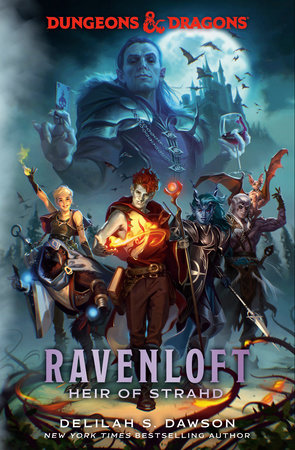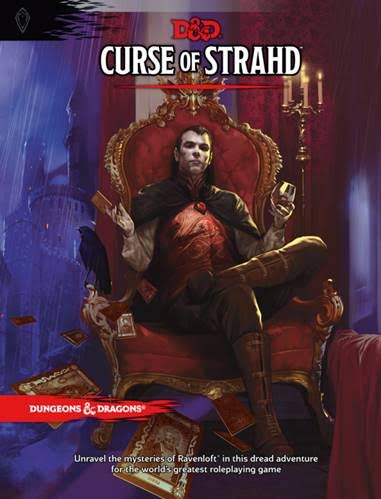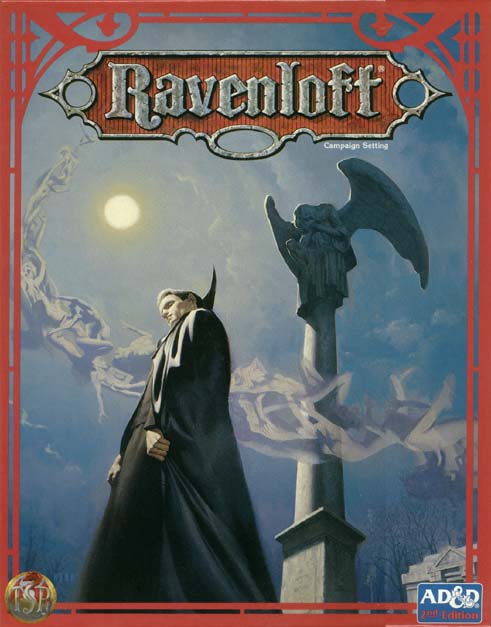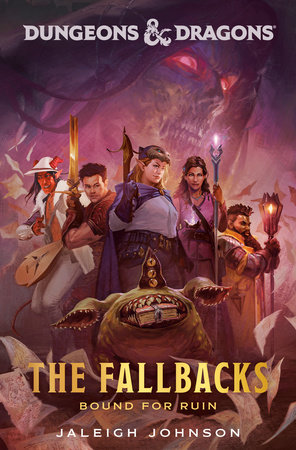Ravenloft Heir of Strahd — a Spoiler-Free Review
Good news for D&D players who also enjoy a bit of gothic horror fiction mixed in with their gaming; a new Ravenloft novel has just been released, and it is just as good as the old Ravenloft books from the ’90s.
Ravenloft’s Long D&D History
 Regardless of which edition of Dungeons & Dragons you play, chances are that you have heard of Ravenloft. The name has been associated with the game since the first edition. The first adventure, simply titled Ravenloft, was published in 1983. Written by Laura and Tracy Hickman, Ravenloft was a milestone that had a huge impact on how future D&D adventures would be written. Also, while D&D had always featured a certain horror element, this adventure arguably heralded the unofficial introduction of gothic horror into D&D. A follow-up adventure, Ravenloft II The House on Gryphon Hill was released in 1986. And that was only the start.
Regardless of which edition of Dungeons & Dragons you play, chances are that you have heard of Ravenloft. The name has been associated with the game since the first edition. The first adventure, simply titled Ravenloft, was published in 1983. Written by Laura and Tracy Hickman, Ravenloft was a milestone that had a huge impact on how future D&D adventures would be written. Also, while D&D had always featured a certain horror element, this adventure arguably heralded the unofficial introduction of gothic horror into D&D. A follow-up adventure, Ravenloft II The House on Gryphon Hill was released in 1986. And that was only the start.
Since then, Ravenloft has appeared in some form in every single edition of the game. In 1990, it was launched as a full-fledged campaign setting for 2nd edition D&D. Ravenloft is an amalgamate of smaller worlds, Domains of Dread, ruled by various Darklords, from a vampire to a death knight, a lich and various other classic D&D monsters. Strahd, the Darklord of the Barovia Domain of Dread, no longer had a monopoly in Ravenloft.
Ravenloft allowed D&D players to experience various venues of gothic horror. The 1990 boxed set was highly popular. A Ravenloft Campaign Setting in hardcover format was also released in 1994 for 2nd edition D&D.
Ravenloft in 5th Edition D&D
Ravenloft still enjoyed its popularity by the time 5th edition D&D rolled around. In 2016, WOTC released Curse of Strahd, an adventure for characters levels one through ten. Complete with a Tarokka deck (Ravenloft’s equivalent of Tarot cards), the adventure was well received. In 2020, a revised edition, Curse of Strahd Revamped was released; a glorious boxed set that was well worth getting even if you had already purchased the original edition. A campaign setting for 5th edition, Van Richten’s Guide to Ravenloft, was also released in 2020, detailing other Domains of Dread beyond Strahd’s Barovia.
Ravenloft in Fiction
A series of highly popular Ravenloft novels was also published, starting in 1991 with Vampire of the Mists written by Christie Golden. While most of the Ravenloft novels were published in the ’90s, the last two, Mithras Court and Black Crusade, were released in 2008.
novels were published in the ’90s, the last two, Mithras Court and Black Crusade, were released in 2008.
With a presence in everything from TTRPG adventures to a D&D world setting, video games (both CRPGs and MMOs) and novels, Ravenloft took on a life of its own, and it still enjoys a strong fanbase today.
While Ravenloft adventures would be reinvented for every succeeding edition of the game, TSR/WOTC stopped publishing the novels at one point (pretty much the same way they stopped publishing Forgotten Realms and Dragonlance novels) to the chagrin of the fans.
With the recent rebirth of D&D-based novels (new Forgotten Realms, Dragonlance and even Spelljammer novels have been published in the past few years), a new Ravenloft novel just had to be in the cards. The new books feel like a homecoming. There are also more on the way with a new R.A. Salvatore book (The Finest Edge of Twilight) coming out this fall and the second Fallbacks novel (Dealing with Dragons) coming out this summer. I was still surprised (elated really!) when Heir of Strahd was announced last March.
Heir of Strahd as the Successor to Ravenloft’s Legacy
As excited as I was about the announcement, I was still a bit apprehensive; Vampire of the Mists, Knight of the Black Rose and Specter of the Black Rose are my all-time favorite Ravenloft novels. All three are tough acts to follow. I wasn’t sure how this latest entry would measure up against the fond memories I have of those books and other Ravenloft novels. My mind was set at ease when I cracked the book open. For some reason, I read the acknowledgments at the end of the book before I started reading Heir of Strahd. It’s barely a page long, but the author, Delilah S. Dawson, in her own words, reveals herself as a huge D&D geek. The kind who would buy the books when she was younger and read them religiously, even when she did not have other people to play the game with (which was a current occurrence in my teens when D&D simply wasn’t well-received or known outside of big cities). Even though she has had a long publishing history, I didn’t know Dawson before picking up this book. I was immediately relieved and felt confident she could deliver a good Ravenloft tale.
So, I expected great things from Heir of Strahd, and I was not disappointed. I was pleasantly surprised by the efforts Dawson made to write a genuine Ravenloft (and D&D) adventure.
It’s a bit hard to talk about this book without spoiling it. (And believe me, this is not a book you want spoiled ̶ it’s full of surprises, twists and turns in the best tradition of previous Ravenloft books.)
A Not-So-Ordinary Cast of Characters
The story begins almost like most D&D campaigns of old where players would “all meet at an inn,” except that, in this case, they all find themselves deposited by  The Mists in Ravenloft. The characters are not your run-of-the-mill D&D characters either. They are all strangers and very different; a diverse group with seemingly nothing in common (at least, at first, and Dawson does a great job revealing the commonality between the characters as the story goes on). There are five of them: There’s the half-orc wizard, Rotrog, arrogant but fuller of himself than actually skilled; a human artificer named Fielle whose sunny personality clashes not only with Ravenloft’s gloomy atmosphere but also with most of the other characters’ personae; Chivaron, an abrasive drow barbarian and his companion, Murder, a Tressym (look it up in the Monster Manual) at once vicious and adorable; Alishai, a bitter tiefling paladin who may have broken her oath and who competes with Chivaron for the nastiest personality; and the kenku priest of Selune, Kah, the most exotic yet most “human” member of the group. They are not friends. They had never met before being dumped in Ravenloft by The Mists. They appear to dislike or distrust each other from the get-go. Mayhem ensues, immediately followed by one of the most grotesque (in a good way) fights in Ravenloft history.
The Mists in Ravenloft. The characters are not your run-of-the-mill D&D characters either. They are all strangers and very different; a diverse group with seemingly nothing in common (at least, at first, and Dawson does a great job revealing the commonality between the characters as the story goes on). There are five of them: There’s the half-orc wizard, Rotrog, arrogant but fuller of himself than actually skilled; a human artificer named Fielle whose sunny personality clashes not only with Ravenloft’s gloomy atmosphere but also with most of the other characters’ personae; Chivaron, an abrasive drow barbarian and his companion, Murder, a Tressym (look it up in the Monster Manual) at once vicious and adorable; Alishai, a bitter tiefling paladin who may have broken her oath and who competes with Chivaron for the nastiest personality; and the kenku priest of Selune, Kah, the most exotic yet most “human” member of the group. They are not friends. They had never met before being dumped in Ravenloft by The Mists. They appear to dislike or distrust each other from the get-go. Mayhem ensues, immediately followed by one of the most grotesque (in a good way) fights in Ravenloft history.
It’s a painful start to the tale with the characters not agreeing on anything and trying to fight monsters that could kill them all. But the mayhem, the clash of personalities, the distrust and the characters’ inability to work as a team are a refreshing change from a typical sword and sorcery story.
Shifting Points of View
Dawson also makes very efficient use of shifting points of view, not only to carry the story forward, but also to help the readers discover each character. Many novels are written in what is called “omniscient third-person point of view.” To some, this is not the best point of view to use, and others will insist that shifting points of view should be avoided. However, in this case, Dawson uses it brilliantly to slowly reveal the traits of each character. For example, the first glimpse of the drow barbarian’s personality comes curtesy from the half-orc’s point of view; it is not a flattering image. The character seems unapproachable and unlikable. A typical barbarian bully. Yet, as the story progresses, and we get more glimpses of his personality through the other characters’ points of view (including his own), he is revealed to be much more approachable, relatable and even likable.
The same can be said of the other characters. These characters all have depth. It’s difficult for an author to flesh out an ensemble cast of characters. Some of these reluctant adventurers could easily have been limited to two-dimensional characters, but Dawson went all out, fleshing them out fully.
When the first battle erupted, I didn’t really care about the characters living or dying. They bicker a lot, adding to the chaos. That first battle goes from bad to worse. Every moment, I expected one or more of the characters to get killed, and it really didn’t bother me much at all. The only character I cared about was Murder, the Tressym. (I have a thing for cats, even if they come with bat wings and a nasty attitude.) It doesn’t take long, however, for the other characters to become more relatable and likable.
Pacing That Enhances Ravenloft’s Atmosphere of Dread
The pace of the story makes you feel like you are part of it. Dawson goes through great length not only to describe the characters, but also the setting itself. She captured Ravenloft’s essence and managed to put it into words that will resonate with fans of the setting. When she describes Castle Ravenloft, you really feel like you’re there.
The characters are also revealed slowly. They are all critically flawed, and this will play a major role in the story. It’s interesting that each character receives an equal amount of attention. Their character arcs are very well developed. And despite their flaws, they are all revealed to be (at least in some measure) relatable and even likable.
Ravenloft’s Many Domains of Dread
Ravenloft is actually an ensemble of mini-settings, each one called a Domain of Dread. Each one is ruled by a darklord. Stradh (the antagonist in this story and a staple of the Ravenloft setting) is the Darklord of Barovia. Lord Soth (originally, from the Dragonlance world setting) is the Darklord of Sithicus, and so on.
The story does not only take part in Barovia. The adventurers also venture into Lamordia. I wasn’t too keen on reading that part of the novel because Lamordia is characterized, among other things, by the creation of “constructs” (i.e., it is the “Frankenstein” Domain of Dread). I always felt body horror did not belong in D&D, but Dawson keeps its to a minimum and the few chapters devoted to Lamordia are actually very entertaining.
characterized, among other things, by the creation of “constructs” (i.e., it is the “Frankenstein” Domain of Dread). I always felt body horror did not belong in D&D, but Dawson keeps its to a minimum and the few chapters devoted to Lamordia are actually very entertaining.
Heir of Strahd Begs for a Sequel
The novel is over 300 pages long, a respectable length, but it reads much too fast. I devoured it in one sitting, and it left me wanting more. The book deserves to sit on the bookshelf next to beloved earlier books in the series. Dungeons & Dragons players who enjoy a little fiction with their tabletop gaming will certainly enjoy this return to Ravenloft. It will be a nice supplement to gamers who have enjoyed the 5th edition adventure Curse of Stradh and even to MMO players who have enjoyed the Ravenloft expansion in both Neverwinter and Dungeons & Dragons Online.
Wil there be more? Undoubtedly! I have a feeling this book will be just as well received as Jaleigh Johnson’s The Fallbacks Bound for Ruin (a Forgotten Realms adventure) published in 2024. The sequel to The Fallbacks is coming out this summer. Heir of Strahd deserves no less.
Check out our article on The Fallbacks Bound for Ruin here!
